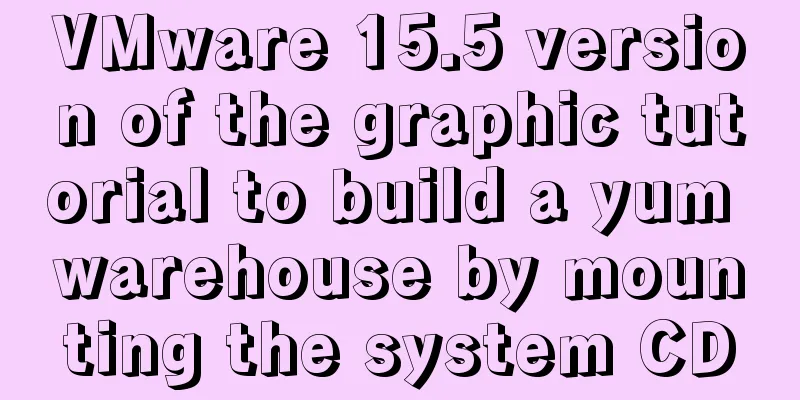How to use selenium+testng to realize web automation in docker

|
Preface After a long time of reading various materials, I finally solved the problem of selenium+testng parameterization! You may be able to find some on the Internet, but these are all my own experiences. This article mainly introduces the relevant content about docker using selenium+testng to realize web automation. Let's take a look at the detailed introduction. Building a web automation environment with selenium+testng under Windows Anyone who has worked in automation must be very familiar with the construction of the selenium web environment, especially the use of selenium in java. First build and install JDK, and configure the Java development environment (if you still don’t know how to do this, you’ll have to play PP). Then download the corresponding selenium jar package from the official website and load it into the project; or use Maven and modify the pom.xml file to directly load the selenium dependency package: <dependency> <groupId>org.seleniumhq.selenium</groupId> <artifactId>selenium-java</artifactId> <version>3.14.0</version> </dependency> Then add the corresponding browser driver file, and the environment is basically ready, and you can start the road of automated testing code. Of course, everyone will also use the popular unit testing framework testng in the process of writing code. How to add testng environment on this basis? In fact, this is not a difficult task. The official website of testng (https://testng.org/doc/index.html) provides instructions on how to install plug-ins in editors such as Eclipse and IEDA. For example, in Eclipse, you can directly enter the Market and search for testng to install it. If you use Maven, you need to add dependency packages to pom.xml: <repositories> <repository> <id>jcenter</id> <name>bintray</name> <url>http://jcenter.bintray.com</url> </repository> </repositories> <dependency> <groupId>org.testng</groupId> <artifactId>testng</artifactId> <version>6.10</version> <scope>test</scope> </dependency> Just wait for the download and installation to complete, then all you have to do is write the code, and then you can express yourself freely. But what I want to introduce today is not the above. This kind of environment is very simple to build. Most people actually know how to do it. There are not many pitfalls. It is just a code environment. What is the trouble we are going to deal with this time? Under the increasingly developed Docker mode, the above compilation environment cannot run on the Linux system. There is no code editor, no interface, and no browser. What should we do? Let’s take a look. Installation and use of Docker Similarly, java+selenium+testng are still needed, but the environment has changed from windows to linux. Regarding the use of docker, here is a brief introduction to the installation and startup process: Use the Then All current images can be listed through the After checking the Linux image, use To enter the container, you can first use docker ps to view all currently running containers. If you cannot find it, it means that the container has not been started or has been shut down. Use Building a Java environment under Docker The Linux in the container is actually the same as the normal Linux operation. First, install JDK: Download the jdk-8u181-linux-x64.tar.gz package; Configure Java environment variables: Edit the environment variable file: vi /etc/profile Add content:
export JAVA_HOME=/root/java/jdk1.8.0_181
export JRE_HOME=${JAVA_HOME}/jre
export CLASSPATH=.:${JAVA_HOME}/lib:${JRE_HOME}/lib
export PATH=${JAVA_HOME}/bin:$PATHRefresh the environment variable configuration: Confirm whether the Java version is effective: At this point, the Java environment has been solved. There is no particular difficulty, just follow it step by step. Testng environment configuration under Docker Next is testng. Because the environment is similar to java and is also related to environment variables, it is solved first: Download the testng-6.14.3.jar package; Continue editing the environment variables file: Add content:
export TESTNG_HOME=/root/java/testng
export CLASSPATH=.:${JAVA_HOME}/lib:${JRE_HOME}/lib:$CLASSPATH:$TESTNG_HOME/testng-6.14.3.jarRefresh the environment variable configuration: Note the testng environment variables here. The CLASSPATH is appended on the basis of the java environment. If you are configuring on Windows, the separator should be changed to; and the calling forms of the environment variables are different. There are some differences. Well, some people may think, isn’t this simple? However, if you continue to execute at this time, you will find that errors begin to appear, which means that a deep pit has come. This is because you are out of the entire development environment. Let's first talk about the execution steps of testng. Suppose you write a test.java file yourself. Remember to keep it simple and don't include other jar packages. The package name is simple and the class name is test: javac test.java java org.testng.TestNG -testclass simple.test It seems very simple, but when executed, there are errors everywhere. When executing javac test.java, common errors are: java.lang.NoClassDefFoundError: com/beust/jcommander/ This is because the jar package used for compilation is missing. You need to download jcommander-1.72.jar. We will place it together with the testng jar package (assuming it is placed in the /root/java/testng/ directory): The CLASSPATH environment variable needs to be appended:
CLASSPATH=.:${JAVA_HOME}/lib:${JRE_HOME}/lib:$CLASSPATH:$TESTNG_HOME/testng-6.14.3.jar:$TESTNG_HOME/jcommander-1.72.jarContinue to refresh the environment configuration: After this, it can usually be compiled smoothly and the test.class file will appear. If other errors occur, such as testng-related packages not existing, etc., please check whether the environment variables are configured correctly. The last step is the operation, which is also the point where most problems will be encountered. Let's talk about the structure first. For example, for the simple.test class above, you need to create a folder simple to store test.java. In the CLASSPATH environment variable, the top-level directory of the testng code files and packages needs to be added, assuming it is /root/java/testng/ /root/java/testng/simple/test.java With this structural premise, you can execute it through the command: java org.testng.TestNG -testclass simple.test The result appears, which means the operation is successful:
If there is a test case @Test in your code, but run shows 0, it means it still failed, but there is no clear error. Of course, this doesn't mean the end yet. Because you may also encounter problems with the lack of various dependent jar packages: These jar packages can be introduced through parameters /root/java/testng/ /root/java/testng/simple/test.java Remotely call the browser under Windows Do you think that everything will be fine once the environment is solved? One more thing, what about the browser? How to solve the problem of no browser? Please use the server that comes with selenium to deploy to a windows machine. The solution to this problem is relatively simple: Download the selenium-server-standalone-3.14.0.jar package; Put it in the specified directory (for example, in the root directory of drive C); cd to this directory: cd C:\ Execute the command to open the selenium remote service: java -jar selenium-server-standalone-3.14.0.jar -port 6666 Next, someone will ask how to specify the browser? You only need to use the following statement in the Java code to call the service just started in Windows:
WebDriver driver = new RemoteWebDriver("http://ip:6666/wd/hub/", DesiredCapabilities.chrome());Also note that the browser driver file is still needed on the server. Just put it together with the jar package and you're done. If you like to tinker, you can study it yourself. The only difference is that you need to bring some parameters when starting the service. The entire docker uses selenium+java to remotely call the Chrome browser under widows to complete the construction of the web automation environment. We will update the writing of web automation code using selenium+testng under docker in the future. Please wait for our next update~ Summarize The above is the full content of this article. I hope that the content of this article will have certain reference learning value for your study or work. If you have any questions, you can leave a message to communicate. Thank you for your support for 123WORDPRESS.COM. You may also be interested in:
|
<<: How to use vite to build vue3 application
>>: MySQL column to row conversion tips (share)
Recommend
CSS achieves colorful and smart shadow effects
background Ever wondered how to create a shadow e...
Complete steps to quickly configure HugePages under Linux system
Preface Regarding HugePages and Oracle database o...
Detailed explanation of how Zabbix monitors the master-slave status of MySQL
After setting up the MySQL master-slave, you ofte...
Data URI and MHTML complete solution for all browsers
Data URI Data URI is a scheme defined by RFC 2397...
Explore how an LED can get you started with the Linux kernel
Table of contents Preface LED Trigger Start explo...
Detailed explanation of the process of realizing calculator function in javascript
Table of contents 1. Introduction to calculator f...
Nest.js authorization verification method example
Table of contents 0x0 Introduction 0x1 RBAC Imple...
Detailed explanation of the perfect solution to the VMware black screen problem after MacOS catalina upgrade
Perfect solution to VMware black screen after Mac...
MySql sharing of null function usage
Functions about null in MySql IFNULL ISNULL NULLI...
Design Tips: We think you will like it
<br />Looking at this title, you may find it...
CSS3 custom scroll bar style::webkit-scrollbar sample code detailed explanation
The default scroll bar style in Windows is ugly, ...
Bootstrap 3.0 learning notes button style
This article mainly explains the style of buttons...
How to distribute two buttons on the left and right sides of the same parent tag using CSS
This article mainly introduces the method of CSS ...
Analysis on the problem of data loss caused by forced refresh of vuex
vuex-persistedstate Core principle: store all vue...
mysql executes sql file and reports error Error: Unknown storage engine'InnoDB' solution
Find the problem I recently encountered a problem...









